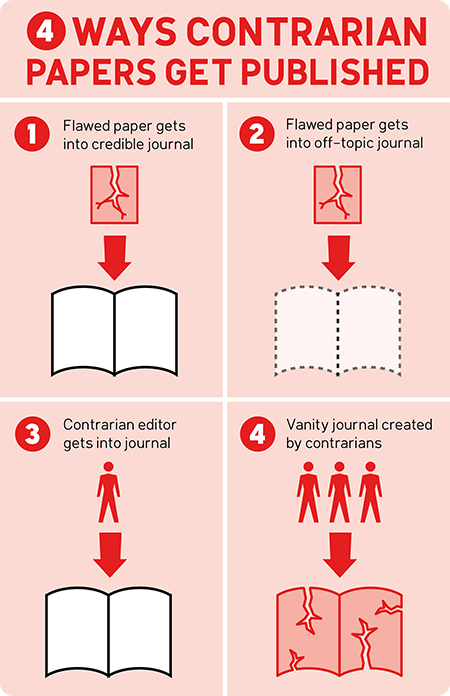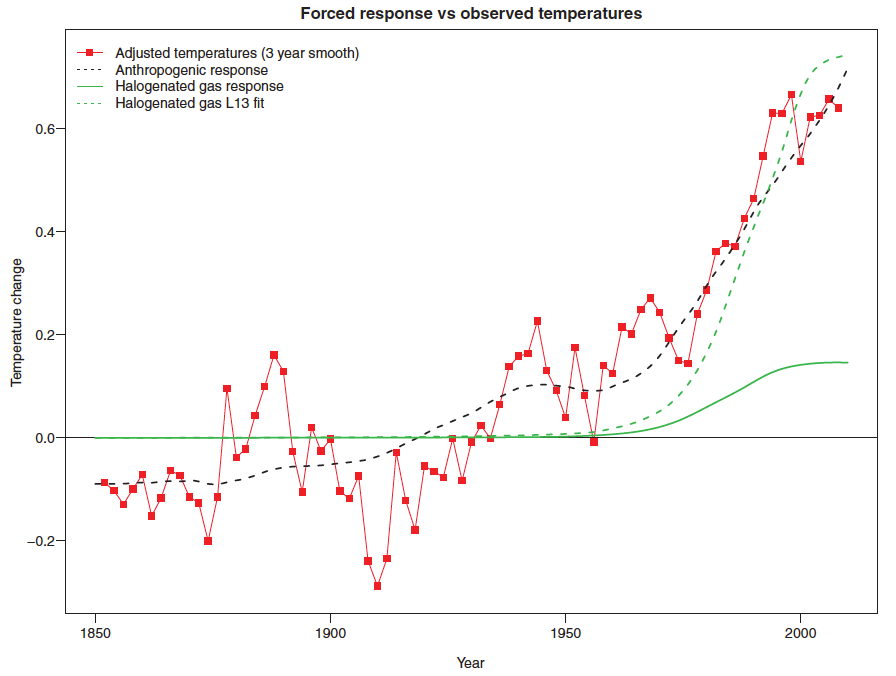Global warming can't be blamed on CFCs – another one bites the dust
Posted on 18 April 2014 by dana1981
A paper published in the International Journal of Modern Physics B by the University of Waterloo's Qing-Bin Lu last year claimed that solar activity and human chlorofluorocarbon (CFC) emissions, not carbon emissions, could explain the observed global warming over the past century. The journal has now published a rebuttal of that paper by Skeptical Science team members Dana Nuccitelli, Kevin Cowtan, Peter Jacobs, Mark Richardson, Robert Way, Anne-Marie Blackburn, Martin Stolpe, and John Cook.
As I recently discussed, contrarian climate research like this blaming global warming on Anything But Carbon (ABC) tends to receive disproportionate media attention. Lu's paper was a prime example, receiving substantial media attention when it was published in May 2013. For example, the paper was trumpeted by a University of Waterloo press release and a Science Daily article, both of which used exaggerated language like "Lu’s theory has been confirmed." ABC News did a better job covering the paper, talking to climate scientist David Karoly, who expressed appropriate skepticism about a paper which purports to overturn decades and even centuries of well-established physics and climate science in one fell swoop. Characteristically, The Australian then criticized ABC News for failing to be "fair and balanced" because they interviewed an actual climate expert about the paper.
As we discussed at the time, the paper contained numerous clear fundamental flaws. For one, the underlying argument was based on "curve fitting" or "overfitting," which is when the variables in a model are arbitrarily scaled to match the observational data. In this case, Lu took the global energy imbalance caused by CFCs (which are greenhouse gases) and scaled them up dramatically to match measurements of global surface temperatures.
Lu then also had to explain why CFCs would be increasing the greenhouse effect, but carbon dioxide wouldn't. To accomplish this, he invoked the saturated gassy argument – claiming that increased CO2 can't cause more warming because there is already so much in the atmosphere that its greenhouse effect has become saturated. This argument was first made by Knut Ångström in 1900, but was conclusively disproved by E. O. Hulburt in 1931 and military research in the 1940s. Lu misinterpreted several recent papers to revive the argument, but as we showed in our paper, it still remains incorrect.
Ultimately Lu's argument was that global surface warming has slowed in recent years, and his model using CFCs and solar activity could accurately match those observations. However, Lu used outdated and superseded surface temperature measurements with a cool bias that exaggerated that surface warming slowdown (HadCRUT3). He also used an extremely outdated reconstruction of solar activity. We showed that even ignoring the unphysical "curve fitting" in his model, models using current known human climate forcings produced a more accurate fit to up-to-date surface temperature measurements (HadCRUT4) than Lu's model (r2 of 0.81 vs. 0.72).
Replication of Lu (2013) Figure 12 using more recent data and a realistic response function. The fit between the anthropogenic forced response (black dashed line) and adjusted temperatures (red squares) is superior to the fit to CFC forcing (green solid line), even allowing for an additional unphysical scaling and lag as in Lu (2o13) (green dashed line).
The extreme curve fitting employed in Lu (2013) is apparent in the above figure, with the solid green line indicating the actual global surface temperature response from the CFC forcing, and the green dashed line indicating the response after the arbitrary scaling by Lu. It's also clear that the temperature response to human forcings (black dashed line) correlates well with the observed temperature changes, with natural forcings and internal variability also accounting for some short-term changes, like the surface warming slowdown over the past 10 to 15 years.
Another key flaw that we discussed in our paper was Lu's failure to account for the entire climate system. Changes in forcings don't just impact surface temperatures; they impact the entire global climate. Thus if CFCs really were the current dominant influence on the global climate, given that they have flattened in recent years (due to the Montreal Protocol), the warming of the entire global climate should also have flattened out. That's simply not the case, as the oceans have continued to warm at a rate equivalent to about 4 Hiroshima atomic bomb detonations per second during that time. As our paper showed, the fundamental flaws in Lu (2013) are numerous.
- It ignores the continued rapid heat accumulation in the oceans
- It relies on unphysical curve fitting
- It tries to revive the long-debunked saturated gassy argument
- It uses outdated data
- Using known forcings dominated by CO2 fits the data better than Lu's flawed model anyway
Our paper concludes,
"We therefore conclude that the hypothesis of L13 is not only inferior to the mainstream explanation of the present climate change, but that it is based on unphysical and fundamentally flawed premises."
The paper fits into Category 2 of the ways flawed contrarian papers get published in scientific journals – by submitting to an off-topic journal.
 Four ways in which flawed research gets published.
Four ways in which flawed research gets published.
It's not uncommon for contrarian research to be published in physics rather than climate journals (for example, Nuccitelli et al. [2012] was a rebuttal to a climate paper published in another physics journal). The editors of off-topic journals may be unable to identify referees with adequate climate expertise to review these climate papers, making it more likely that the sorts of fundamental flaws that were the basis of Lu (2013) won't be identified during the peer-review process, and hence more likely that this flawed research will be published in off-topic journals.
It's important to note that contrarian research is often useful in challenging and advancing our scientific understanding. However, as Carl Sagan once said,
"They laughed at Columbus, they laughed at Fulton, they laughed at the Wright brothers. But they also laughed at Bozo the Clown."
As our Cosmopolis paper recently showed, unlike the human-caused global warming theory, contrarian hypotheses have not withstood scientific scrutiny or the test of time. The media tends to give papers like Lu (2013) disproportionate attention because controversy sells and because many people don't want to believe humans are engaging in dangerous disruption of the global climate system. We doubt that our rebuttal will receive nearly as much media attention. However, when these papers are published in off-topic journals, that's a red flag that they may not have been subjected to rigorous expert peer-review, and that their claims should be strongly scrutinized before being uncritically passed along for public consumption. In this respect, Science Daily failed, but ABC News deserves praise for soliciting expert opinion in their coverage of this paper.
The journal also published a response to our paper from Lu, although it fails to substantively address the points we raised. We believe a disinterested reader will not have any difficulty in determining which paper is correct. The journal also published a comment by Müller & Grooß (2014), who rebutted a portion of Lu (2013) that we didn't touch upon – the claim that galactic cosmic rays are responsible for ozone depletion and the hole in the ozone layer. The journal also allowed Lu to respond to that critique.
Ultimately we can chalk CFCs up to another failed Anything But Carbon (ABC) hypothesis. The list of contradictory ABCs is extensive, for example blaming global warming on the sun, ocean cycles, CFCs, galactic cosmic rays, and volcanoes, all of which contradict the claims that the planet isn't warming or that it's cooling. Other contrarians contradict all of these arguments by accepting the reality of human-caused global warming, instead claiming that the climate just isn't sensitive to the increased greenhouse effect, or that global warming is a good thing. While the expert consensus on human-caused global warming is consistent and cohesive, it seems like no two contrarians can agree on an alternative hypothesis, quite simply because none except human-caused global warming is supported by the full body of scientific evidence.
Note: Nuccitelli et al. (2014) been incorporated into the rebuttals to It's CFCs































 Arguments
Arguments































I would have thought Lu's paper unpublishable, but I suppose it falls into category #2: flawed paper in off-topic journal.
A selection from one (of many) lists of impact factors for 2012 journals (physics)
Fantastic job to all involved! Well done.
Lu has been pushing this pet hypothesis of his for a while now, so it is good to see it soundly refuted in the peer-reviewed scientific literature. Another fake skeptic myth busted, and another influential SkS journal paper too :)
"The journal also allowed Lu to respond to that critique."
Allowing authors to reply to comments is standard practice, of course. What is unusual is the angry and personal nature of Lu's replies, at least judging from the abstracts. This is particularly the case in the reply to Müller and Grooß.
Magma @3,
Agreed. It is unfortunate that the journal permitted Lu's vitriolic remarks to stand-- allowing such strong language in a journal is unusual.
I shudder to think what his papers read like. IMO, Lu's snarky and angry replies are consistent with the fake skeptics' tendency to try and obfuscate criticisms of their work with bluster and Gish gallops and to never, under any circumstances, admit fault or wrong doing. Lu had a potentially novel idea, it was wrong, and he now needs to accept that and move on (difficult as that may be).
I side with HughBat. The figure you show does suggest that the fluorocarbons contribute around 0.15C of warming, leveling off since 2000. How much extra warming would these have caused if their concentration had continued to rise since 2000?
There are grains of truth in all research. The tricky part is scaling back the exaggeration. This one required a scaling back to perhaps 1/5 of the claim?
Unusually, I chose to read Mr Lu's paper to see what it was all about. I must commend the Skeptical Science authors on their restraint in assessing the paper and commenting on it. I have never trusted papers that resort to emotive hyperboles in describing the state of knowledge and their findings. They always smack of ego exceeding intellectual capacity and rigour and almost always indicate serious amounts of confirmational bias. Snide negative commentary about others (yes Albatross his paper is much like his rebuttals) just reinforce my lack of trust.
Mr Lu clearly has a favourite topic which is CFCs and he seems to think they rule the world and much of what goes on in it. His purpose appears to be more one of proving just how important they are - and by inference how important he is because he knows more about them than others do. A clear case of FIGJAM.
I found his comments about CFC processes related to ozone reasonably well argued and supported. I haven't taken the time to check out all the references though, but this appears to be his area of speciality and possibly expertise.
The leap from these analyses to climate impacts is less than impressive. He makes the most basic, amateurish mistake of implying causality from statistical correlation. I am quite surprised that any journal with aspirations of professionalism could allow this type of reasoning to be presented as scientific - especially one that purports to be about physics.
Lu's proposition is entirely dependent on his bald statement that the warming effect from CO2 is saturated. The statement looked suspicious and the arguments and analyses presented to support the statement are so clearly and obviously flawed that all following inferences must be rejected. So I was pleased to hear that the proposition was debunked long ago.
Mr Lu may well know lots about CFCs, but he needs to improve his methods of analysis and inference.